Topics
Relations and Functions
Relations and Functions
Inverse Trigonometric Functions
Algebra
Calculus
Matrices
- Introduction of Matrices
- Order of a Matrix
- Types of Matrices
- Equality of Matrices
- Introduction of Operations on Matrices
- Addition of Matrices
- Multiplication of a Matrix by a Scalar
- Properties of Matrix Addition
- Properties of Scalar Multiplication of a Matrix
- Multiplication of Matrices
- Properties of Multiplication of Matrices
- Transpose of a Matrix
- Properties of Transpose of the Matrices
- Symmetric and Skew Symmetric Matrices
- Invertible Matrices
- Inverse of a Matrix by Elementary Transformation
- Multiplication of Two Matrices
- Negative of Matrix
- Subtraction of Matrices
- Proof of the Uniqueness of Inverse
- Elementary Transformations
- Matrices Notation
Determinants
- Introduction of Determinant
- Determinants of Matrix of Order One and Two
- Determinant of a Matrix of Order 3 × 3
- Area of a Triangle
- Minors and Co-factors
- Inverse of a Square Matrix by the Adjoint Method
- Applications of Determinants and Matrices
- Elementary Transformations
- Properties of Determinants
- Determinant of a Square Matrix
- Rule A=KB
Vectors and Three-dimensional Geometry
Linear Programming
Continuity and Differentiability
- Concept of Continuity
- Algebra of Continuous Functions
- Concept of Differentiability
- Derivatives of Composite Functions - Chain Rule
- Derivatives of Implicit Functions
- Derivatives of Inverse Trigonometric Functions
- Exponential and Logarithmic Functions
- Logarithmic Differentiation
- Derivatives of Functions in Parametric Forms
- Second Order Derivative
- Derivative - Exponential and Log
- Proof Derivative X^n Sin Cos Tan
- Infinite Series
- Higher Order Derivative
- Continuous Function of Point
- Mean Value Theorem
Applications of Derivatives
- Introduction to Applications of Derivatives
- Rate of Change of Bodies or Quantities
- Increasing and Decreasing Functions
- Maxima and Minima
- Maximum and Minimum Values of a Function in a Closed Interval
- Simple Problems on Applications of Derivatives
- Graph of Maxima and Minima
- Approximations
- Tangents and Normals
Probability
Integrals
- Introduction of Integrals
- Integration as an Inverse Process of Differentiation
- Some Properties of Indefinite Integral
- Methods of Integration: Integration by Substitution
- Integration Using Trigonometric Identities
- Integrals of Some Particular Functions
- Methods of Integration: Integration Using Partial Fractions
- Methods of Integration: Integration by Parts
- Fundamental Theorem of Calculus
- Evaluation of Definite Integrals by Substitution
- Properties of Definite Integrals
- Definite Integrals
- Indefinite Integral Problems
- Comparison Between Differentiation and Integration
- Geometrical Interpretation of Indefinite Integrals
- Indefinite Integral by Inspection
- Definite Integral as the Limit of a Sum
- Evaluation of Simple Integrals of the Following Types and Problems
Sets
- Sets
Applications of the Integrals
Differential Equations
- Differential Equations
- Order and Degree of a Differential Equation
- General and Particular Solutions of a Differential Equation
- Linear Differential Equations
- Homogeneous Differential Equations
- Solutions of Linear Differential Equation
- Differential Equations with Variables Separable Method
- Formation of a Differential Equation Whose General Solution is Given
- Procedure to Form a Differential Equation that Will Represent a Given Family of Curves
Vectors
- Introduction of Vector
- Basic Concepts of Vector Algebra
- Direction Cosines
- Vectors and Their Types
- Addition of Vectors
- Properties of Vector Addition
- Multiplication of a Vector by a Scalar
- Components of Vector
- Vector Joining Two Points
- Section Formula
- Vector (Or Cross) Product of Two Vectors
- Scalar (Or Dot) Product of Two Vectors
- Projection of a Vector on a Line
- Geometrical Interpretation of Scalar
- Scalar Triple Product of Vectors
- Position Vector of a Point Dividing a Line Segment in a Given Ratio
- Magnitude and Direction of a Vector
- Vectors Examples and Solutions
- Introduction of Product of Two Vectors
Three - Dimensional Geometry
- Introduction of Three Dimensional Geometry
- Direction Cosines and Direction Ratios of a Line
- Relation Between Direction Ratio and Direction Cosines
- Equation of a Line in Space
- Angle Between Two Lines
- Shortest Distance Between Two Lines
- Three - Dimensional Geometry Examples and Solutions
- Equation of a Plane Passing Through Three Non Collinear Points
- Intercept Form of the Equation of a Plane
- Coplanarity of Two Lines
- Distance of a Point from a Plane
- Angle Between Line and a Plane
- Angle Between Two Planes
- Vector and Cartesian Equation of a Plane
- Equation of a Plane in Normal Form
- Equation of a Plane Perpendicular to a Given Vector and Passing Through a Given Point
- Distance of a Point from a Plane
- Plane Passing Through the Intersection of Two Given Planes
Linear Programming
Probability
- Introduction of Probability
- Conditional Probability
- Properties of Conditional Probability
- Multiplication Theorem on Probability
- Independent Events
- Bayes’ Theorem
- Variance of a Random Variable
- Probability Examples and Solutions
- Random Variables and Its Probability Distributions
- Mean of a Random Variable
- Bernoulli Trials and Binomial Distribution
- Types of Function based on Elements:
1) One One Function (or injective)
2) Many One Function
3) Onto Function (or surjective)
4) One One and Onto Function (or bijective)
5) Into Function
6) Constant Function - Types of Function based on Equation:
1) Identity Function
2) Linear Function
3) Quadratic Function
4) Cubic Function
5) Polynomial Functions - Types of Function based on the Range:
1) Modulus Function
2) Rational Function
3) Signum Function
4) Even and Odd Functions
5) Periodic Functions
6) Greatest Integer Function
7) Inverse Function
8) Composite Functions - Types of Function based on the Domain:
1) Algebraic Functions
2) Trigonometric Functions
3) Logarithmic Functions - Explicit and Implicit Functions
- Value of a Function
- Equal Functions
Notes
A funcion is a connection between 2 sets A and B f: A→B such that
1) All elements in A are associated to some element in B
2) This association is unique, that means one and only one.
Let's try to understand this with a simple anology,
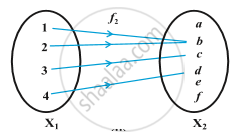
Here, let's say `"X"_1` is a set of all children and `"X"_2` is a set of all womens. And `"X"_1` and `"X"_2` have connection as mother and children.
So as per the definition there is a connention between 2 sets `"X"_1` and `"X"_2` such that all the elements of `"X"_1` are associated to some element in set `"X"_2` i.e all the childrens are related to a particualr mother, and this association is unique because no one child can have two or more mothers, but a mother can have more than one child.
Examples-
X= {1,2,3,4}
Y= {1,5,,9,11,15,16}
Are the following relations functions?
a) `"f"_1`= {(1,1), (2,11), (3,1), (4,15)}
As per the definition this is the function.
b) `"f"_2`= {(1,1), (2,7), (3,5)}
This is not a function because 4 is not related with any element in set Y.
c) `"f"_3`= {(1,5), (2,9), (3,1), (4,5), (2,11)}
This is not a function because 2 is associated to 9&11.
This can also be written as `"f"_3`(2)= 9 and `"f"_3`(2)= 11
i.e f(x)=y
(x,y)∈f
⦁ Domain of a Function- Domain is known as the input of a functin where all the values of x, for which f(x) stays defined or gives a valid answer.
Example- f(x)= x^3- 3
x∈R, so R is the domain here.
⦁ Range of a Function- It the ouput of a function. The range of a function is the complete set of all possible resulting values of the dependent variable (y, usually), after we have substituted the domain. The definition means the range is the resulting y-values we get after substituting all the possible x-values.
Example- `f(x)= sqrt(x-1)`
`y= sqrt(x-1)`
`y^2= x-1`
`x= y^2+ 1`
y∈R, so R is the range here.
⦁ Co-domain of a funcion- The codomain or target set of a function is the set Y into which all of the output of the function is constrained to fall. It is the set Y in the notation f: X → Y.
Types of functions-
1) One one (injective) function- If each element have single image, the it is a one one function.
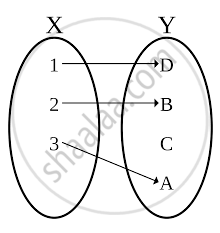
Example- f(x)= 2x+3
if x=1, then y=5
x=2, y=7
`x=1/2, y= 4` Here, every element of x have a separate value of y, thus it is a one one function.
One one function is further split into two parts
i) Onto one one function- If each element of the codomain is mapped to by at least one element of the domain is an onto one one function. Co-domain= Range i.e y= f(x)
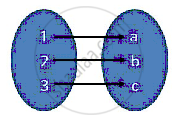
ii)Into one one function- If each element of the codomain is not mapped to any one element of the domain it is an into one one funcion.
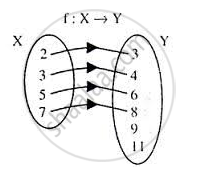
2) Many one (surjective) function- In mathematics, a function f from a set X to a set Y is surjective, or a surjection, if for every element y in the codomain Y of f there is at least one element x in the domain X of f such that f(x) = y. It is not required that x be unique; the function f may map one or more elements of X to the same element of Y.

Example- `"f"(x)= x^2`
if x=1, then y= 1
x= -1, y= 1
x=2, y= 4
x= -2, y= 4
Here, element of y have more than one values of x, thus it is a onto function.
Many one function is further split into two parts
i) Onto many one funcion- If two or more element of domain have one image and codomain is equal to range then it is said to be Onto many one function.
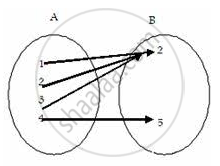
ii) Into many one function- If two or more element of domain have one image and codomain is not equal to range then it is said to be Into many one function.


